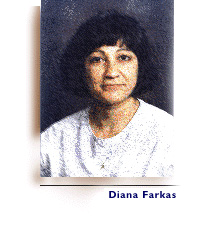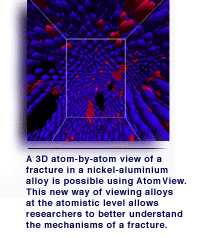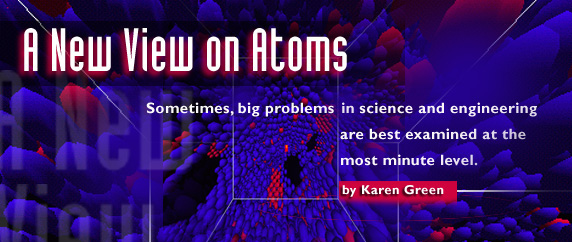


For Diana Farkas, a researcher at the Center for Modeling and Simulation in Materials Science at Virginia Tech (VT), that means studying the development of fractures in intermetallic alloys by examining the alloys, especially their defects, atom by atom. For more than 12 years, Farkas and her research team have studied new and promising alloys at the atomic level, looking at the bonds between atoms in defective alloy crystals, and how they behave under different levels of external applied stress.
The goal of the research is to develop new structural materials that hold up to extreme heat, resist oxidation, and have a high degree of ductility in combination with strength. The work has important implications in the field of materials design, including aircraft and aerospace design. It is funded by the Office of Naval Research, Division of Materials Science and the National Science Foundation.
"We are looking at the characteristics of experimental alloys, such as whether they are brittle or ductile, and whether they maintain their strength at high temperatures," explains Farkas. "We look at what happens in the propagation of fractures at the atomic level. We need to understand the mechanisms of the fracture process in order to design materials with improved ductility and the ability to maintain strength at high temperatures."
Farkas gets her data from computer simulations, which are based on a description of the atomic interaction fit to the equilibrium properties of defective atomic crystals. She then uses a FORTRAN code to calculate the atomistic equilibrium configuration of the defects--either cracks or plastic deformation in the alloys. Until recently, the research team could view the data only as two-dimensional slices on a desktop workstation. These two-dimensional visualization packages are far from perfect; for one, they can't handle the large number of atoms involved in the massive simulations necessary to study the propagation of cracks. Furthermore, two-dimensional renderings can't give a complete picture of a problem that is truly three-dimensional in nature. But in the last few months, Farkas has been able to "see" her data in a new and much more realistic light. Using an application called AtomView, Farkas can now study the behavior of atoms in propagating cracks in the immersive, three-dimensional environment of the CAVETM.
The development of AtomView is a direct result of Virginia Tech's involvement in the National Computational Science Alliance. John Shalf, a visualization research programmer at the National Center for Supercomputing Applications (NCSA), the leading-edge site for the Alliance, worked with Ron Kriz of VT's Advanced Communication and Information Technology Center during the summer of 1997 and helped him write an application that took Farkas's FORTRAN code output--numerical representations of the positions of every atom in a fracture being studied--and put it into the visual 3D form that became AtomView. Shalf's help in creating AtomView was part of the training offered during NCSA's Visual Supercomputing Institute, a program held each year to help scientists utilize the tools of the CAVE and ImmersaDesk virtual environments.
"They came to the VSI with their simulation data in hand," Shalf recalls of the VT research team. "Because of that, it was possible for me to get them started by helping them get a very simple application running that could read their data." Since the Visual Supercomputing Institute, VT researchers have taken over the development of AtomView and are busy extending its capabilities in ways that are useful to Farkas's research team. As a partner in the Alliance, VT researchers will continue to develop and evaluate VR tools and applications such as AtomView in their newly installed CAVE. When appropriate, these tools and applications will be disseminated to other Alliance partners and the larger scientific community.
AtomView, says Kriz, is one of the first success stories to emerge from VT's Alliance collaboration to develop and disseminate cutting-edge visualization tools and applications. "This project was designed in the spirit of developing CAVE applications remotely for viewing animations of supercomputing simulations," Kriz says. "I anticipate that this CAVE application will be further developed and shared by Virginia Tech and NCSA as PACI partners."
For researchers like Farkas, AtomView means the opportunity to view bigger blocks of data from any angle, and the ability to view 3D simulations of the fracture process for the first time.
"Imagine walking between the atoms in an alloy and you get the idea of what it is like to view this information in AtomView in the CAVE," says Farkas. "The beauty is you are able to see something that is very close to a real fracture, only you are seeing it at the atomic level."
According to Shalf, AtomView is a better tool for looking at alloy fractures and defects at the atomic level because the researcher can see many more levels of atoms at once. "They want to see what's happening at the crack tip, and that's a phenomenon that happens in three dimensions, not on a flat surface," he says. "You need a tool that can handle the large number of atoms involved in 3D simulations. Using a tool like this, you can look in three dimensions instead of one or two, and see what's happening at all levels."
A simulation of the fracture process, for example, requires data on at least 100,000 atoms, according to Farkas, and needs the power of 128 processors on NCSA's SGI/CRAY Origin2000 supercomputer. Utilizing the speed and the performance of the Origin2000, Farkas hopes to soon run AtomView simulations that examine as many as 1 million atoms.
"We are already seeing a three orders of magnitude increase in the number of atoms we are looking at," she says. "It used to be that we barely had enough memory on computers to handle 2D data. Now we have enough memory to simulate materials in full 3D. We need tools to understand this 3D data and the CAVE and AtomView are a very important part of this."
Bigger simulations that look at the mechanisms of fractures in a realistic manner mean more information about what happens in the fracture process, especially at the critical region of the crack tip. And understanding what happens to cause fractures and other defects is an important step in developing stronger, more ductile materials. It's a way of tackling the big problems of engineering by looking at the tiniest pieces of matter--but in ever more massive chunks.
With the bigger simulations "there is time saved and there is more information to be studied," says Farkas. "And with the Alliance and NCSA, there is an emphasis on collaboration instead of competition. In the long run, you get a lot more done."
AtomView is now being refined by Farkas's research team. The current version is now
available for download at:
http://www.sv.vt.edu/future/vt-cave/VT/index.html#proj.
